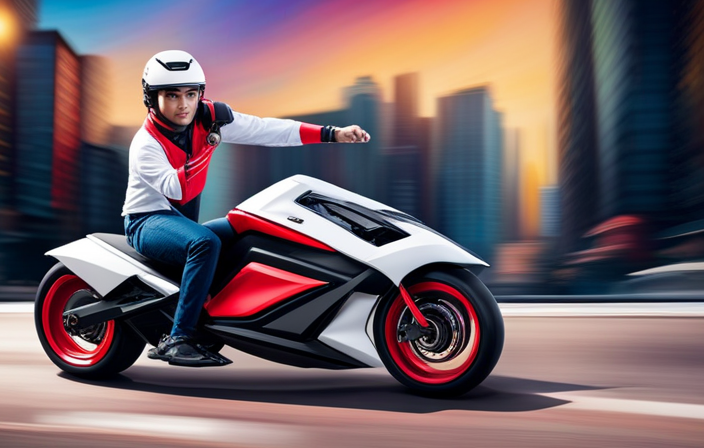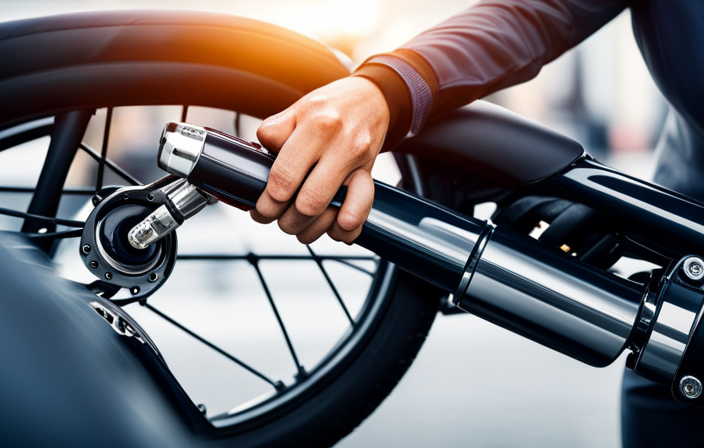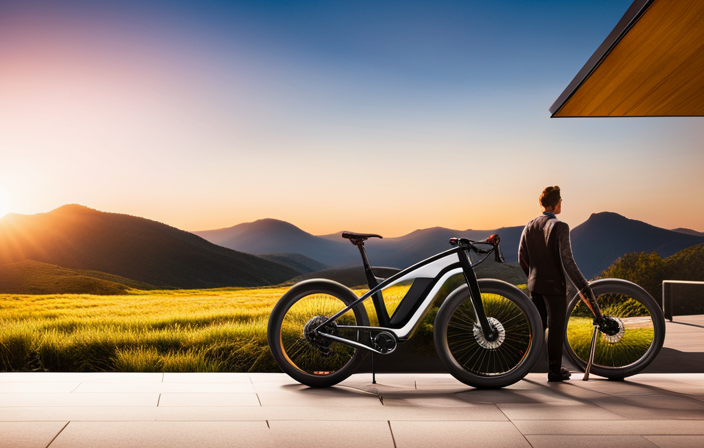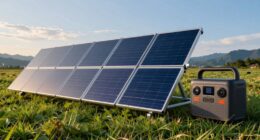Get ready to feel the wind in your hair and the thrill of the open road as we dive into the exhilarating world of electric bike speed. Imagine the rush of effortlessly gliding along at high speeds, powered by cutting-edge electric motors.
In this article, I will guide you through the factors that affect electric bike speed, help you choose the right bike for maximum velocity, and provide tips on how to push your limits.
So, buckle up and get ready to experience the electrifying speed of an electric bike like never before!
Key Takeaways
- Regular maintenance and inspection of drivetrain components, lubrication of the chain, and proper gear alignment are essential for optimal performance.
- Maintaining a proper riding position, applying consistent pedal pressure, and optimizing power transfer through smooth pedaling motion can help increase speed.
- Lowering wind resistance by tucking elbows in and lowering the head can also contribute to faster acceleration.
- Wearing a helmet, using protective gear, familiarizing yourself with the bike’s braking system, practicing emergency stops, and riding in designated bike lanes or on roads with minimal traffic are crucial for safety.
Understanding Electric Bike Speed
You can easily understand how fast you can go on an electric bike. Understanding acceleration and measuring top speed are key factors in determining the speed capabilities of an electric bike.
When it comes to acceleration, electric bikes are known for their impressive torque, allowing you to quickly reach higher speeds. The instant power delivery provided by the electric motor ensures a smooth and exhilarating ride.
Measuring the top speed of an electric bike depends on various factors such as the motor power, battery capacity, and weight of the bike. High-end electric bikes can reach speeds of up to 28 mph, while some models offer even higher speeds. Keep in mind that the top speed may also be limited by local regulations.
So, whether you’re looking for a thrilling ride or a convenient mode of transportation, electric bikes can definitely satisfy your need for speed.
The Power of Electric Motors
The speed at which an electric bike can accelerate is determined by the power of its motor. Electric motors play a crucial role in the performance of electric bikes, as they convert electrical energy into mechanical energy, propelling the bike forward. The efficiency of the electric motor is a key factor in how fast an electric bike can go. A more efficient motor will convert a higher percentage of the electrical energy into mechanical energy, resulting in a faster acceleration and higher top speed.
Electric bikes offer several benefits when it comes to speed. Firstly, their instant torque allows for quick acceleration, making them ideal for city commuting or navigating through traffic. Additionally, electric bikes can reach higher speeds than traditional bicycles, allowing for a faster and more exhilarating ride. Lastly, the ability to maintain a constant speed without much effort makes electric bikes a great option for longer rides or hilly terrains.
In summary, the power and efficiency of the electric motor are crucial factors in determining the speed of an electric bike. With their ability to provide instant torque and reach higher speeds, electric bikes offer a thrilling and efficient way to get around.
Factors Affecting Electric Bike Speed
Factors affecting the speed of an e-bike include the motor power, battery capacity, weight of the rider, and terrain. When it comes to acceleration, the motor power is a crucial factor. The higher the power, the faster the bike can go. A powerful motor allows for quick acceleration, making it easier to reach higher speeds in a shorter amount of time.
Additionally, the battery capacity plays a significant role in determining the speed of an e-bike. A larger battery capacity provides more power and allows for longer rides at higher speeds.
Moreover, the weight of the rider can affect the speed of the e-bike. A lighter rider will have less impact on the overall speed compared to a heavier rider.
Lastly, the terrain can greatly impact the speed of an e-bike. Uphill slopes will naturally slow down the bike, while flat or downhill terrains will enable the bike to reach higher speeds more easily.
Considering these factors, it is clear that motor power, battery capacity, rider weight, and terrain all play a crucial role in determining the speed of an e-bike.
Choosing the Right Electric Bike for Speed
When selecting an e-bike for speed, it’s important to consider the motor power, battery capacity, rider weight, and terrain.
These factors play a crucial role in determining how fast you can go on an electric bike.
Firstly, the motor power of an electric bike directly impacts its speed. Look for well-known electric bike brands that offer high-performance motors. They often provide more power and better acceleration, allowing you to reach higher speeds effortlessly.
Secondly, battery capacity is essential for maintaining speed over longer distances. Opt for a bike with a larger battery capacity, as it will provide more energy and enable you to ride at higher speeds for a longer duration.
Additionally, your body weight affects the bike’s speed. Lighter riders generally achieve higher speeds compared to heavier riders due to reduced overall weight.
Lastly, consider the terrain you’ll be riding on. If you plan to ride on hilly or uneven surfaces, a bike with a higher power motor and larger battery capacity is ideal for maintaining speed.
When choosing an electric bike for speed, remember to find a balance between power, battery capacity, and your specific riding needs. Speed and range go hand in hand, so choose wisely to find the perfect electric bike for your requirements.
How to Maximize Your Electric Bike’s Speed
To maximize your e-bike’s speed, it’s important to focus on optimizing motor power, battery capacity, and your riding technique.
Maximizing acceleration is key to achieving higher speeds on an electric bike. Look for a bike with a powerful motor that can provide a quick burst of speed when needed. Additionally, a larger battery capacity will allow you to maintain higher speeds for longer periods of time.
To improve aerodynamics, consider adding accessories like fenders and racks that can create drag. Streamline your riding position by keeping your body low and close to the bike, and tuck in your elbows and knees. This will reduce wind resistance and help you achieve higher speeds.
By paying attention to these factors, you can unlock the full potential of your electric bike and enjoy thrilling rides at top speeds.
Safety Considerations at High Speeds
For your safety, it’s crucial to consider certain factors when riding at high speeds on an e-bike.
When traveling at higher speeds, it’s important to have the right safety gear. A helmet is a must-have to protect your head in case of any unexpected accidents. Additionally, wearing knee and elbow pads can provide extra protection for your joints.
Another essential aspect is mastering proper braking techniques. Being able to brake effectively and efficiently is crucial when riding at high speeds. Practice using both your front and rear brakes to distribute the braking force evenly. Remember to gradually apply the brakes instead of slamming them, as this can cause skidding and loss of control.
By wearing the right safety gear and mastering proper braking techniques, you can enjoy the thrill of high-speed riding on your e-bike while keeping yourself safe.
Legal Speed Limits for Electric Bikes
When it comes to riding an electric bike at high speeds, safety should always be a top priority. However, it’s important to also be aware of the legal speed limits that apply to electric bikes.
Speed regulation is put in place to ensure the safety of riders and others on the road. While the specific speed limits may vary depending on the country or region, most places have restrictions in place for electric bikes. These limits are typically lower than those for motor vehicles, as electric bikes are considered to be a form of pedal-assisted transportation.
It’s crucial to familiarize yourself with the legal restrictions in your area to avoid any potential fines or legal consequences. Riding within the legal speed limits not only keeps you in compliance with the law but also helps to maintain a safe riding environment for everyone.
Maintaining Your Electric Bike’s Speed Performance
Make sure you regularly check and maintain your e-bike to ensure it maintains its speed performance.
One of the key factors in maintaining your electric bike’s speed performance is improving acceleration. To achieve this, you can start by regularly cleaning and inspecting the drivetrain components, such as the chain, gears, and cassette. Ensure that the chain is properly lubricated and the gears are properly aligned.
Additionally, check the tire pressure regularly as underinflated tires can hinder your bike’s acceleration.
Another important aspect is maintaining the top speed of your electric bike. This can be done by regularly checking the battery’s charge level and ensuring it is fully charged before each ride. Also, keep an eye on the overall condition of the battery, and if necessary, consider replacing it to maintain optimal performance.
By following these maintenance practices, you can ensure that your electric bike maintains its speed performance and provides you with a thrilling ride every time.
Tips for Increasing Your Speed on an Electric Bike
To increase your speed on an e-bike, it’s important to focus on maintaining a proper riding position and pedaling technique. Here are some tips to help you achieve faster acceleration and improve your aerodynamics:
-
Get in the right position: Lean forward slightly and keep your elbows bent to reduce wind resistance and maintain control.
-
Pedal efficiently: Apply consistent pressure on the pedals and maintain a smooth pedaling motion. This will optimize power transfer and increase your speed.
-
Use the right gear: Shift to a lower gear when starting from a stop to maximize acceleration. As you gain speed, shift to a higher gear to maintain momentum.
-
Reduce wind resistance: Tuck your elbows in, lower your head, and keep your body streamlined to minimize drag. This will help you cut through the wind and increase your overall speed.
By implementing these techniques, you’ll be able to maximize your e-bike’s speed and enjoy a thrilling ride.
Exploring the Thrill of High-Speed Electric Biking
Experiencing the exhilaration of high-speed e-biking is an incredible sensation. As an avid electric bike rider, I have explored the thrill of pushing the limits and reaching top speeds. But before you embark on your own high-speed adventure, it’s crucial to understand the safety measures and acceleration capabilities of your electric bike.
To ensure your safety, always wear a helmet and protective gear. Familiarize yourself with the bike’s braking system and practice emergency stops. Additionally, make sure to ride in designated bike lanes or on roads with minimal traffic to minimize the risk of accidents.
Understanding your bike’s acceleration capabilities is essential for a smooth and controlled ride. Different electric bikes have varying acceleration modes, so take the time to familiarize yourself with your bike’s settings. Gradually increase the speed and pay attention to how the bike responds.
Now, let’s explore the exhilarating world of high-speed electric biking through this handy table:
| Safety Measures | Acceleration Tips |
|---|---|
| Wear a helmet | Gradually increase speed |
| Use protective gear | Pay attention to bike’s response |
| Practice emergency stops | Familiarize yourself with acceleration modes |
| Ride in designated bike lanes | |
| Choose roads with minimal traffic |
With a thorough understanding of safety measures and acceleration capabilities, you can confidently explore the thrill of high-speed electric biking. So, buckle up, hold on tight, and get ready for an electrifying ride!
Frequently Asked Questions
How much does an electric bike typically cost?
Electric bike prices vary depending on factors such as brand, features, and battery capacity. Quality e-bikes can range from $500 to $10,000 or more. It’s important to consider your needs and budget when choosing the perfect electric bike for you.
Are there any age restrictions for riding an electric bike?
Age restrictions for riding an electric bike vary depending on the country and local regulations. In some places, there may be a minimum age requirement, while others may require a driver’s license or specific certifications. It’s important to familiarize yourself with the legal requirements in your area.
Can I ride an electric bike in the rain?
Yes, you can ride an electric bike in the rain. It’s important to use riding techniques like gentle acceleration and braking, and maintain your bike by drying it off afterwards, lubricating the chain, and checking the brakes regularly.
How long does it take to charge the battery of an electric bike?
Charging time for an electric bike battery depends on its capacity. Typically, it takes around 3-6 hours to fully charge. It’s important to choose a bike with a battery that suits your needs for longer rides.
Are there any specific safety gear recommendations for riding at high speeds on an electric bike?
When riding an electric bike at high speeds, it is crucial to prioritize safety. Wearing a helmet is of utmost importance to protect your head in case of any accidents. Additionally, mastering proper riding techniques is essential for maintaining control and stability.
Conclusion
After diving deep into the world of electric bikes and uncovering the secrets to unlocking their incredible speed potential, I am left in awe.
The juxtaposition of power and efficiency that these bikes possess is simply mind-blowing. With the right electric bike and a few tips and tricks up your sleeve, you can experience the thrill of high-speed biking like never before.
So, why wait? Embrace the exhilaration and freedom that comes with zooming through the streets on an electric bike. The world is yours to explore, at lightning speed.









